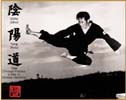Short Hyung (Dan Hyung)
Joong Gook Jan Dong Moo Sool Took Su Hyung Bope: These movements require a lot of flexibility, coordination, strength and speed. You can develop properly only if you follow the right steps. These Hyung develop extra strength in small muscle groups which otherwise are very difficult to develop. Short Hyungs vary from 5 to 35 minutes per technique (set).
Note: Further explanation will come in the lesson.
- Pal Gae Quan: (1 - 8 sets) - Develops an internal and external foundation for beginning or advanced Hyung (set movement).
- Every joint and muscle is developed and strengthened to attain flexibility, coordination, strength and speed throughout the entire body. Pal Gae is performed to build the proper foundation for Moo Doe.
- While practicing the Pal Gae movements, the body position switches in all directions; East, West, North, South.
- Practicing Pal Gae balances the entire body.
- The specific benefits of practicing Pal Gae include:
- An overall increase in joint flexibility.
- An overall increase of joint strength.
- Increased bone marrow strength.
- Increased oxygen penetration throughout the body.
- An increase of flexibility and strength inside the joints.
- Some of the benefits of Pal Gae are clearly understood by studying the 3rd and 4th movements:
- Strength is transferred from one area of the body to another with each movement: to the toes, fingertips, eyes and face.
- The practitioner looks over the shoulder toward the finger tips grouped together as one, while the toes of the foot are turned 270°.
- Body strength moves from the stronger side toward the weaker side, fully-balancing the body and creating harmony.
- Bone strength is developed evenly throughout the entire body.
- With the alignment of the bones, the proper position of the entire body, and proper focus of the eyes, every joint is conditioned to perfect harmony, which builds tremendous strength.
- The 26 bones and joints of the spine are conditioned to be in perfect alignment, allowing a person to comfortably sit in the same position for a very long period
of time
- Practicing improperly may cause the body to favor one side over the other, developing an imbalance, and creating problems within the joints.
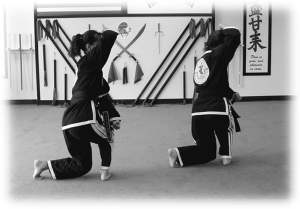 |
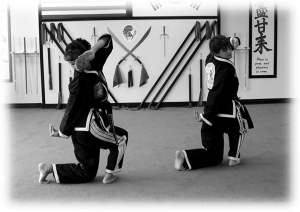 |
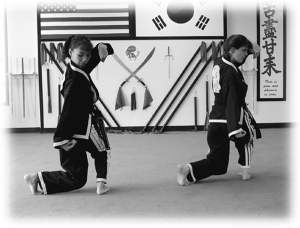 |
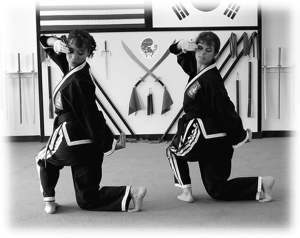 |
| The 3rd and 4th movments from the first set of Pal Gye. |
Pal Gae has been more deeply explained here (intermediate level) to further your understanding of the depth of Moo Doe movement.
- Tang Soo Quan (1-8 sets) - Explodes like a firecracker, moves like a cyclone and then releases like a bamboo stick, usually attacks are below the waist and side to side. The steps must be followed in the correct order, otherwise, the joints will be off-balanced and there will be loss of strength.
- Jung Yu (1-12 sets) - Requires great flexibility. Releases like a geyser. The attacks are above the shoulder, usually towards the face. Attacks are from low to high. Develops great leg strength. The control is like that of a spring.
- Tang Oo Quan (1-12) - Splashes like water from a bucket using your entire body. The movement is soft, then explodes (pictured below).
- Pyung Soo Quan (1-8 sets) - Level attacks. Feet slide. Hands strike above the waist with level position to elbow, shoulder and hand.
- Byung Tang (1-9 sets) - Movement is like scattering stones. Hands and feet are used in all directions.
- Jang Yung (1-8 sets) - Movement comes from a long bamboo stick. Predominately uses the hands. Open hands or fists move from side to side. Feet zigzag.
- Pyung Yang Soo Gook (1-10 sets) - Movement is like that of scattering stones. Open hands and fists are used. Coiled attacks are like that of a spring.
- Koo Poe Quan (9 sets) - The movement is like a waterfall with open hands and feet, using nine different attacks and defenses, moving from side to side (pictured below).
- Hai E Ti (1-14 sets) - Comes from the branch of a willow tree whipping in the wind. Strikes are with the back part of the hand. One hand continuously follows the other in very fast movement. Used as offense and defense. A lot of shoulder movement is used.
- Doo Doe Gee (1-10 sets) - Movement is like that of a mole. Attacks are below the waist at the knee and ankle. Fingers are together like an eagle's beak. A lot of speed is required (pictured below).
- Sin Hyung (1-8 sets) - Movement is like that of smoke. Open hands are used. The attack is made, then the attacker appears to vanish. Both offense and defense are executed in the same movement. The attack causes internal damage to the opponents body. This Hyung requires great mental concentration.
- Pyung Bope (1-10 sets) - Movement is like that of an avalanche of rock. Jumping up, then attacking below the waist upon moving down. Uses mostly the feet with very little hand movement. Develops great leg strength
- Tee Pee (1-10 sets) - Comes from the idea of snapping a small bamboo stick. Movements are short and very quick. Usually strikes are directed toward the upper body.
- Sang Joo Quan (1-12 sets) - Movement comes from that of a sling. Moves with speed, then strikes while turning.
- Il Gyok (1-8 sets) - Movement is like that of a log swinging at the end of a rope, using both hands and feet. Used as offense and defense (pictured below).
- Ma Boo Quan (1-24 sets) - Movement comes from that of whipping a horse: in side to side motions, while riding on it's back.
- Yuk Ma Quan (1-8 sets) - Movement is like that of a wagon wheel. Uses closed fists, locked elbows and moves in a circle. Very powerful movement combines offensive and defensive action together.
- Wae Jang Ti Kwik (1-10 sets) - One open hand attack then followed by kick technique. Offense and defense is used together to attack low and high. Develops great back strength.
- Tang Bake Bong Quan (1-10 sets) - Comes from the idea of an erupting volcano. Both hands are open. Body swings in a big circle (360° or more). Attacks are directed to the upper body at the end of the movement.
- Sin Gong Quan Bope (1-10 sets) - Movement comes from that of a circling tornado. The attacker surrounds the opponent's body while attacking. Offense and defense movements are executed. Uses the entire body, making the opponent dizzy. Requires great mental concentration.
Note: Each of these Hyungs has a minimum of 8 sets and a maximum of 24 sets.
|
